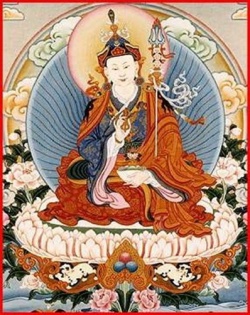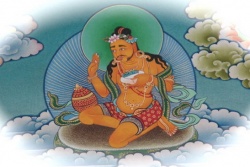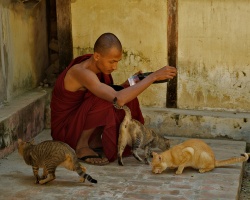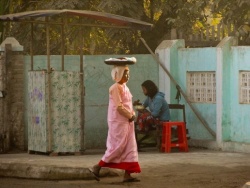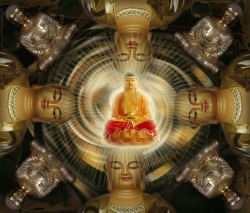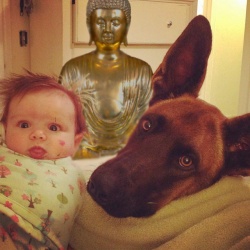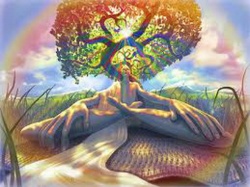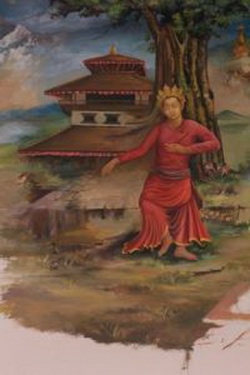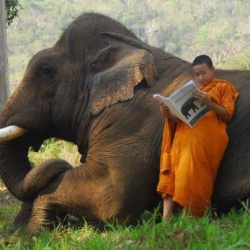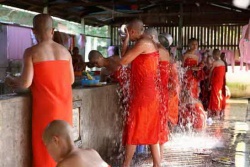Marriage: Is there a Buddhist wedding ceremony?
The word wedding has come to refer to the ceremonial or official beginning of a marriage. Marriage implies the marrying or mixing together of two family lines or lineages, usually for the purpose of combining property or other resources, and most often, for the raising of children.
What Constitutes a Buddhist Wedding?
The Mangala Sutra Pali: sutta is the selection from Buddhist scripture that is often read aloud by the officiating person or preceptor.
(A mangala auspicious necklace] is the triple-knotted cord placed around an Indian bride's neck by the groom. ) Mangalam is a Sanskrit word meaning blessing; it also carries the associated idea of auspiciousness.
Suggestions for a ceremony from a Theravada Buddhist site.
The Maha Mangala Sutra
Thus, I have heard:
Once, the Buddha was staying at the monastery donated by Anatapindika in Jetavana Grove near Shravasti. When it was quite late in the night, a heavenly being whose surpassing splendor illuminated the entire grove appeared near the Exalted One, respectfully saluted Him and then stood to one side.
Standing there, he addressed the Exalted One in verse:
Many deities, and people yearning after good, have pondered blessings; tell me what the highest blessing is.
~
Not to associate with fools,
To associate with the wise,
And pay honour to those who are worthy of honour,
That is the Highest Blessing.
To reside in a suitable place,
To have done meritorious actions in the past,
And to set oneself on the right course,
That is the Highest Blessing.
Much learning, perfect craft,
Well trained in discipline and pleasant speech,
That is the Highest Blessing.
The support of mother and father;
The cherishing of wife and children,
And peaceful occupations,
That is the Highest Blessing.
Generosity; practicing the Doctrine,
The helping of relatives,
And blameless activity,
This is the Highest Blessing.
To cease and abstain from evil;
Forbearance with intoxicants,
And steadfastness in virtue,
That is the Highest Blessing.
To have reverence, humility,
Contentment and gratitude,
And to hear the Dharma at an appropriate time,
That is the Highest Blessing.
To have patience, attentiveness;
An environment where members of the Order
And timely discussion of the Dharma can occur,
That is the Highest Blessing.
To practice self-control, and meditation,
Understanding of the Four Noble Truths,
And the realization of Nirvana,
That is the Highest Blessing.
One whose mind does not flutter,
By contact with the demands of the world;
Sorrow-less, stainless and secure,
That is the Highest Blessing.
To them fulfilling matters such as these;
Everywhere invincible,
In every way moving happily,
These are the Highest Blessings.
There is no standardized Buddhist marriage ceremony, Tibetan or Western, since marriage is not generally considered a religious matter. Therefore, every Buddhist community has its own wedding tradition that is more tied to culture than religion.
For example, in Japan, the traditional wedding is a Shinto ritual, since fertility and marriage are considered the province of nature and the local kami -- spirits or deities.
Buddhism, there, plays a more important role at the time of a death.
That is the way things are done, too, in Korea and China where there is not thought to be any conflict among the three systems: Taoist, Confucian and Buddhist.
In fact, marriage has only been considered a religious matter in the Western world since the time of the Protestant Reformation.
The new focus by Luther on the individual and the family led the Catholic Church to begin to do the same.
Prior to that, married life was clearly considered inferior to monastic life.
The famous words of St. Paul that it is better "to marry than to burn" may as well apply to the Buddhist approach, as well. [It is generally agreed, that here to burn means with desire or with distracting lust.]
The rituals of marriage, such as the exchange of rings, the lavish use of flowers and the throwing of grain all stem from the customs of the Romans. The white gown is a fairly new idea; it was a fashion started by Queen Victoria in the early nineteenth century.
It is still too early to determine whether Buddhism has found a home in Western societies.
If/when it does, then it will be integrated into the culture the way it was in China, Japan, Thailand and Tibet and people will undoubtedly want wedding ceremonies to accommodate it.
Marriage
In Tibet, Nepal, Bhutan and so on, it was not uncommon for a man to have more than one wife (polygyny,) sometimes women who are sisters. It is not at all unheard of for one woman to be married to more than one man (polyandry,) usually brothers.
Example of polyandry, Bhutan (excerpt BBC "Tribe." see 2:20minute)
Both types of polygamy appear in the traditional literature of India and Tibet, but today monogamy is the most usual form of marriage.
Kashmiri Hindu wedding.
South India.
Khmer (Cambodian) wedding
Then you may want to go for contrast, to 1st century weddings or those even earlier:
Marriage in Ancient Greece
Wedding in ancient Greece and Rome.
Buddhist monastics do not perform marriage ceremonies, but they can bless the people. In the USA, there is rarely a distinction between these two functions:
"Khenpo Karthar Rinpoche married us, ... , at KTD in the shrine room in the old building in March of 1982. He told us that it was to be on the 21st, the first day of spring and in the morning. We wanted afternoon, but he said no, that one BEGINS something in the morning. We complied (of course).
He performed several weddings that I know of, and they were all performed in the shrine room, in the traditional manner with family and friends present. ... . ... .
What I remember was the following:
Beautiful designs in rice on the cushions, a double dorje on one, and another design on the other, for the bride and groom to sit on. We were told which one was for which (but I don't remember).
Ceremonial saffron rice with raisins and butter [and] Tibetan tea [were] served. Not to eat or drink like food, but as a ceremonial partaking.
Khenpo giving a talk that could have been at ANY wedding of any denomination, admonishing us to be kind to one another and be exclusive to one another. Prayers chanted by the lamas before and after. Scarves of [5] different color silks attached to an arrow waved over our heads representing skillful means and other meaningful symbolism as represented by the colors.
Afterwards, Khenpo signed the marriage license for us. Hey, it was
beautiful and sacred and in keeping with our beliefs. I cannot think of a better place to have been married than at KTD in the shrine room. "
~ E. Ruut, to the Kagyu emailing list, 2002
Sex
Buddhism does not address sexuality as long as it causes no disharmony, harm to others or to those participating in it.
Some orders of monks and nuns are celibate [avoid sexual contact,] but many Buddhist practitioners, teachers and others, are not.
Briefly, celibacy is encouraged by many religious institutions because it seeks to cut the ties that people naturally feel for their own bodies and for physical existence.
For people believing in rebirth, sex is to be avoided because it is the lure by which beings are enticed to take rebirth in physical form into the round of incessant suffering that is samsara.
Sample a chapter of Bernard Faure's The Red Thread: Buddhist Approaches to Sexuality. Princeton U. Press, 1998.
~~~~~~~~~~~~~~~~~~~~~~~~~~~~~~~~~~~~~~~
Among Tibetans, the status of consort is an acknowledged one, and there is no shame attached to it.
In a social context, the person may be referred to as the lama's "mandala," and the woman may have the honorary title of "dakini" (Tib.: kha'dro.) (Within the context of ritual practice, the partner is referred to as "mudra.")
As in every society, sometimes the uncertainty of a relationship gives rise to gossip; it can also lead to social conflict - - in that case, the parties may do well to marry.

